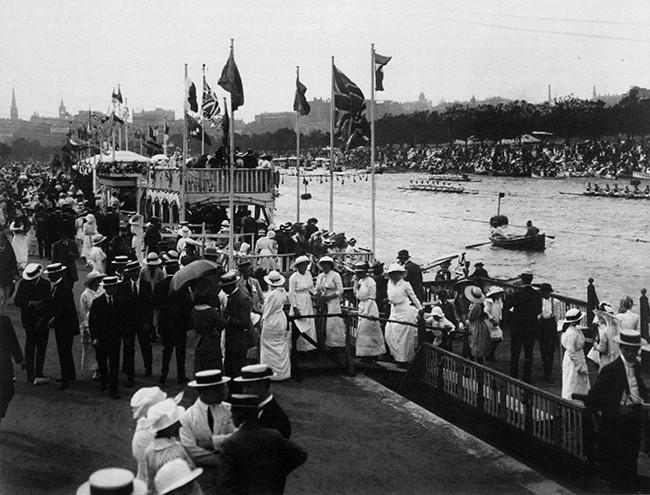Norman Nation
Mercantile Rowing Club (VIC)
Norman was one of six Mercantile members who died in WWI. Three of them came from just one junior eight which won at Henley in 1914, the last full season before the war. The three were: William Cumberland, Norman Nation and Norman Johnson.
This crew obviously enjoyed their rowing and the company of each other. They had won the maiden eight double at Upper Yarra and Albert Park Lake Regattas in the previous season and had kept together through winter to race at the junior level in 1914.

Above: Norman in the four seat of his winning junior eight at Henley 1914
Henley regatta in those days was not only then first major regatta of the season in late October, but also the biggest and most prestigious non Championship regatta in Australia.
WWI not only devastated the next generation of oarsmen in Mercantile, but throughout Australian rowing.
The impact of their loss on the club and his crew mates was severe. In the 1921-22 season, three new fours were named in the honour of these three friends.

Above: Australian Henley in 1914
Norman Nation was aged 27 and a half years old when he joined up in December 1915 at the recruiting office at Melbourne Town Hall. He was a relatively tall man for that time being a six footer but very light. He was the perfect build for a modern lightweight.
He was the only child of Charles and Phoebe Nation and was born in Sydney. In Melbourne, they lived in Armadale. He was listed variously as an accountant and a clerk in his working life and the army initially put him to work in Melbourne. He was promoted to corporal on 16th April 1916. However as the war continued on, reinforcements were needed. On 1st August 1916, he departed Melbourne for France. He returned to the rank of private and joined the front line soldiering in France with 24th Battalion. He was taken down badly with mumps in November and December 1916 which left him unfit for duty. Once back on duty, he was rapidly promoted to lance corporal in February 1917 and on 11th May 1917 promoted to Second Lieutenant as a temporary Commission of the British Army. To be promoted in the field to an officer obviously indicates a man of leadership skills.
The lifespan of front line officers in WWI on the Western Front was short, akin to the lifespan of WWII bomber pilots. Fortunately for us Arthur Atkins survived WWII, but unfortunately for us, Norman Nation did notI. He died in the attack on Daisy Wood on 9th October 1917, the first stages of the Passchendaele battle. He was shot in the head from sniper fire.
By way of background, Passchendaele lay on the last ridge east of Ypres [Eepres], 8 km from a railway junction at Roulers, which was a vital supply system of the German 4th Army.
This campaign in Flanders was controversial in 1917 and has remained so today. The losses were severe and better options were ignored.
I will extract a few words from Charles Bean who recorded the disastrous events of the day when Norman died.
The [Australian] 6th Brigade attached on a front of 1,200 yards with all four battalions, their objectives from north to south being as follows:
23rd Battalion – Rhine (beyond Daisy Wood)
21st Battalion Knoll 28 (beyond interval between Dairy and Daisy Woods)
24th Battalion – Edge of Busy Wood (beyond Daisy Wood) [This was Norman Battalion.]
22nd Battalion – Neighbourhood of old German headquarters at sandpit on Moorslede Road.
Their average strength of each Battalion at the starting point was only 7 officers and 150 others.
So thin was the barrage that from the first, the German machine guns played almost with impunity upon the advancing parties. On the right the two detachments of 22nd under Captain Bunning and Lieutenant Anderson, attacking the neighbourhood of the old German headquarters at the sandpit, reached the area of their objective, dug in with the German post close beside them, and suffered heavily in the fighting with these.
Observers on the sand Hummock on Boonseinde Ridge 5th October 1917 can be seen of the image.
Next on the left, the 24th Battalion had 200 yards to go before reaching Daisy Wood. Halfway across it met strong rifle fire from the wood, and the right company, under Captain Williams went a little further on, and was checked by opposition from the hedges near the sandpit.
At that hour only the flashes of the enemy’s shots could be seen. First Williams, then Lieutenant Pickett (of Bullecourt fame), going forward to bomb these German, were shot dead, and Lieutenant Nations was wounded, but Sargent Prime with a dozen surviving men formed a post at the southern corner of the wood. Meanwhile the left company had just reached the wood when a machine gun was suddenly switched upon it from near Dairy Wood, 150 yards further north. This almost wiped out the left.
I will leave Charles Bean at this point.
The whole operation was a disaster with Norman’s 24th Battalion suffering the worst casualties with 9 officers and 104 men listed as casualties.
Let us dwell for a second on what Norman, together with Captain Williams and Lieutenant Pickett did. They advanced into enemy fire to bomb the German positions. They led this dangerous task from the front. It was an act of great courage, valour and leadership.
The image on the screen is Australian front line at Broodseinde Ridge 5 Oct 1917 just prior to this action.
Norman was buried by a party from his Battalion on the day of his death near Polygon Wood, approximately 500m NE of Broodseinde. His body was found and reinterred into the Tyne Cot British Cemetery at Passchendaele in 1921.
In 1918, his mother Phoebe collected his possessions and commission from the Army.
Andrew Guerin April 2015

